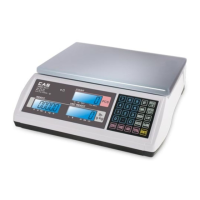
Do you have a question about the CAS EC-II Series and is the answer not in the manual?
| Display | LCD |
|---|---|
| Tare Range | Full Capacity |
| Auto Power Off | Yes |
| Readability | 1g |
| Operating Temperature | 40°C |
| Units | g, oz, lb |
Guidelines for optimal scale operation environment, avoiding drafts, corrosion, vibration, and extreme temperatures.
Instructions on how to properly level the scale using its adjustable feet and built-in level indicator.
Procedure for switching the scale on and initial warm-up period recommendations.
Lists all items included in the scale package, such as the scale, adapter, and connectors.
Diagram and labels identifying the main components of the scale, including platter and ports.
Explains the function of the weight, unit weight, and count display windows on the scale.
Details the meaning of various symbols shown on the scale display, such as NET, ZERO, and STABLE.
Describes the function of each key on the scale's keypad, including numeric and special function keys.
Details the pinout and function of the remote connector for external platforms.
Explains connections for external displays and control boxes.
Describes the serial communication port for data output to PCs or printers.
Procedure for powering the scale on and off, including display indications.
How to reset the scale display to zero to compensate for drifting.
Steps for preparing the scale for counting items by sampling unknown or known unit weights.
Method for counting items using a known reduction unit weight by placing and removing samples.
Guide on how to save product data (PLU) including item number and name into memory cells.
Process for taring or subtracting container weight when it's known or unknown.
How to accumulate weight or quantity readings, and recall or clear accumulated data.
Setting high/low limits for counting accuracy checks, with audible alarms.
Setting high/low limits for weight accuracy checks, with audible alarms.
How to switch between local and remote platforms for scale operation.
Setting the automatic power-off timer for the scale from predefined options.
Configuring the display backlight settings to Auto or Manual mode.
Switching measurement units between kilograms/grams and pounds.
Enabling or disabling the unit weight recalculation function for accuracy.
Configuring data transmission methods (manual or auto) for different devices.
Setting the communication speed (baud rate) for data transmission.
Customizing the format for label printing when a label printer is connected.
Selecting between 'in' (inside) and 'out' (outside) alarm types for checks.
Configuring how tare weight can be canceled, either continuously or one-time.
Enabling or disabling the remote platform functionality on the scale.
Managing the transmission of three-section control signals for external devices.
Setting data transmission methods (Stable or Series) for an external display.
Configuring the communication speed (baud rate) for the extra display.
Adjusting the range for automatic zero tracking to maintain zero stability.
Setting the range for zero display adjustments to ensure accurate readings.
Defining the range for display stability criteria to ensure consistent readings.
Setting the rate for determining display stability, affecting zero point stability.
Steps to enter and perform simple calibration by entering a code during startup.
Choosing the unit (kg/g or lb) for calibration based on platform type.
Details the available power supply options: AC Adapter and DC 12V/800mA.
Information on using the internal battery, charging indicators, and charging procedures.
Specifies the UART signal mode (E1A-RS 232C) and general data transmission format parameters.
Details data formats for series transmit and accumulation transmit modes.
Lists variables used in scale/printer output and commands sent from PC to scale.
Lists common error codes (E1-E5, OL), their possible causes, and recommended handling procedures.
Specifications for capacity and readability (e=d) in g and lb versions.
Details external/internal resolution and minimum recommended sample/unit weights.
Covers display type, units, zero range, stabilization time, ports, temp, and humidity.
Information on power adapter, battery life, and charging requirements.
Details calibration methods, safe overload capacity, and product weight.
Provides product weight, dimensions, and pan size in millimeters and inches.